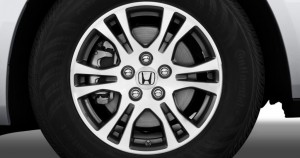 The tires are some of the hardest working parts of any vehicle. Because they’re such an important part of ensuring you stay safe on the road, it’s crucial that you maintain your tires and replace them when they’re too worn. At the same time, buying four tires at once is an expensive proposition, so you don’t want to get new ones prematurely. Browse this guide for tips on proper tire maintenance and service.
The tires are some of the hardest working parts of any vehicle. Because they’re such an important part of ensuring you stay safe on the road, it’s crucial that you maintain your tires and replace them when they’re too worn. At the same time, buying four tires at once is an expensive proposition, so you don’t want to get new ones prematurely. Browse this guide for tips on proper tire maintenance and service.
Find out if Your Tires Are Balanced
When it comes to your tires, balance is key. Having professionals at a dealership balance your tires prevents uneven wear on the treads and sidewalls, a less bumpy ride, and minimal vibration in the cabin.
Ideally, you should have your tires balanced every 3,000 to 6,000 miles. However, if you begin to feel vibrations in the floorboard, steering wheel, or seat, have the balance checked sooner.
Have the Tires Rotated
Even if you regularly have your tires balanced, they will still tend to wear unevenly with one or two of your tires taking more abuse than the others because of their position on your car. Front tires typically have more wear on their outer edges because they lean when you go into a turn. For this reason, it’s a good idea to have your tires rotated so you don’t have excessive wear on the front two.
At the dealership, an experienced technician will move your tires from one wheel to another. When you drop off your car for the rotation, ask the service team to evaluate the condition of your brakes because it’s easier to see them when the tires are off the vehicle.
Keep Tabs on Air Pressure
Check the air pressure in your tires every couple of weeks. You can buy a simple, inexpensive air pressure gauge to help you keep tabs. When you keep your tires inflated to the manufacturer’s recommended levels, you can expect them to last longer due to less wear. Without proper air pressure, your tires will need more energy to move because they have greater rolling resistance from being underinflated. As a result, your vehicle will be less fuel efficient.
Air pressure also impacts handling, making it more difficult to initiate turns. As a final note on air pressure, under-inflated tires are more prone to blowing out, a problem that can cause a serious accident.
Regularly Check the Treads
The tire treads have several important jobs such as getting rid of water when you travel on wet roads. Each month, it’s a good idea to inspect the treads on each tire. Look for worn or bald spots for visual clues that it’s time to replace your tires. There’s also a test you can do using a quarter. Insert the coin in the tread so that Washington’s head is directed down into the tire. If the top of his head is not visible, the tread has adequate depth and you can keep driving on the tire. Seeing the top of his head means your tread is dangerously worn and you need to shop for new tires.
Take the tire monitoring and maintenance steps listed here to stay safe, improve handling, and increase fuel economy.




